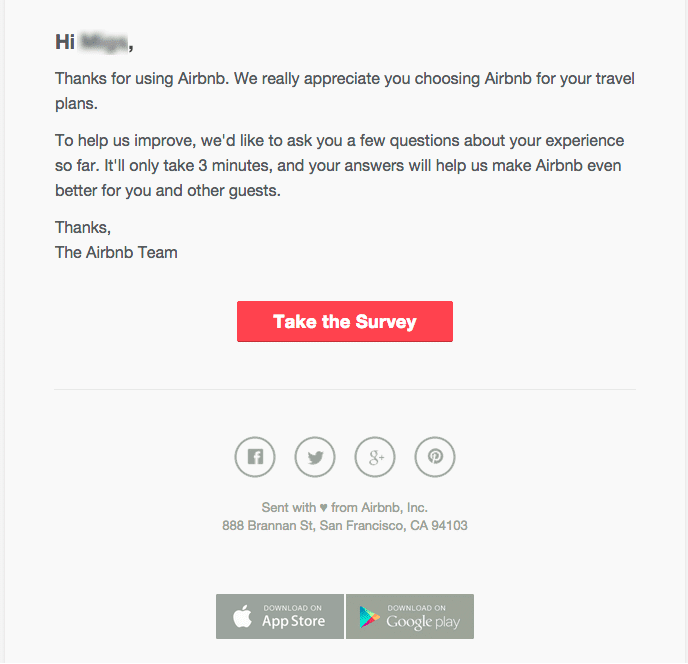What is the best way to get customer feedback? However you go about obtaining it, there’s no denying that dealing with customer feedback is essential to running a business. Learning how to take it, run with it, and implement it will form your customer feedback process.
One of the best pieces of advice when it comes to a customer feedback process is “don’t be intimidated.” It takes effort, and there are tons of factors to consider, but it’s well worth it. Because no matter how good your product or service is, someone, somewhere, is going to have an issue. So it’s best to be prepared.
In this article, we’ll look at:
- The benefits of customer feedback
- 4 steps to creating a great customer feedback process
- 4 examples of brands that successfully implemented customer feedback
Are you implementing your customers’ feedback? See how customer-obsessed your business is—take the quiz! 👇
The benefits of customer feedback
The biggest benefit of customer feedback is also the most obvious: it gives you insight into your products and services and therefore helps you improve them.
Let’s say, for example, you’re launching a new type of software. Perfect launches of brand-new products are rare. Even with focus groups, testers, or if you hire a QA engineer (quality assurance engineers), the first wave of paying customers is likely to find problems.
Here’s a tweet that sums it up pretty well:

A good customer feedback system, for any type of business, is essential. Feedback will help you measure your customer satisfaction, and if implemented correctly, it shows customers that you value their opinions and concerns.
Your system will also show you if your overall business strategy is working: are you speaking to your target audience? Are your products successful with the demographic you’ve been marketing to? Done right, collecting feedback will generate a wealth of insights.
Customer feedback success stories often draw more customers to your business—and can help you keep up your customer retention rate too. Use this valuable feedback to create loyal customers who will value your brand, choose it over competitors, and recommend it to their friends, families, and colleagues.
Before we talk about some examples, here’s one more fact to keep in mind: customer feedback is a continuous loop. Once you’ve collected and resolved it, you need to follow up, collect more, and keep resolving. Customer feedback will never end, so a good system requires constant vigilance.
How to create a customer feedback process in 4 steps
There are countless methods of collecting customer feedback, so you’ll need to decide which ones are right for you and your business. Don’t let the possibilities overwhelm you—here’s a step-by-step guide to creating a customer feedback process that will help you to continuously improve.
[ebook-download title=”How customer-obsessed is your business?” link=”https://netstorage.ringcentral.com/documents/quiz_how_customer_obsessed_your_business.pdf” cta-text=”Take the quiz” src=””]
1. Measure customer satisfaction
Monitoring satisfaction over time is tremendously useful to a business and will show you what’s working and what isn’t. You can track your happy customers through a variety of methods and a variety of channels. Let’s break them down, starting with the methods.
The methods
Method 1: customer satisfaction rating
A customer satisfaction (or CSAT for short) rating simply asks customers how satisfied they are with your business. It should use an understandable scale, from numerical (such as 1 for extremely dissatisfied to 10 for extremely satisfied) to visual (unhappy face, neutral face, happy face).
These ratings are usually accompanied by an open-ended satisfaction survey question asking how to improve for next time. CSAT scores are easy to collect and don’t require much effort on behalf of the customer. But they’re also not very in-depth.
Method 2: Net Promoter Score
The Net Promoter Score, or NPS for short, is another commonly used method. It asks the question “How likely is it that you would recommend our company/product/service to a friend or colleague?” The answer is scored on a scale from 1 to 10, with 1 being the lowest and 10 the highest.
The NPS goes deeper than the CSAT rating because it not only scores satisfaction, but also loyalty. Think about it this way: would you rather have a satisfied customer, or a loyal customer?
At first, that may seem like a strange question. But just because a customer is satisfied doesn’t mean they’re going to go out and recommend you to their friends or colleagues, or that they’ll even keep coming back. In contrast, a loyal customer is more likely to do both.
As with the CSAT, an NPS question should be followed by an open-ended question asking for more details, such as why the respondent would recommend your business.
These two basic measurement methods are used globally for all types of comments. Using a tool like RingCentral Surveys, you can quickly and easily build surveys for your customers while measuring NPS, Customer Effort scores, and more.
But how do you get your answers? Here are the most common channels for businesses to engage with their customers.
The channels
A) Email surveys

If you’ve ever sent a welcome email to your customers, that means you have their email addresses. Which means they’ve probably purchased your product or signed up for newsletters/alerts… Which makes them the perfect people to ask for feedback.
Make sure to word your emails in a way that tells customers their feedback is important to you, as this will make them more likely to respond.
Interested in email marketing? Here are a few email marketing templates you can use.
B) Your company website

People who visit your website are there for a reason, so it makes sense to ask visitors for feedback. This can be done easily and quickly through in-site chats and pop-ups.
Either way, your site should have a detailed contact page. Contact forms, email addresses, and/or phone numbers should all be listed. A key part of your customer service principles should be to make sure your customers know their voices are being heard—don’t restrict their ability to contact you!
Learn more about customer service teamwork.
Perhaps your site also contains support pages. If so, Google Analytics is great for monitoring visitors to your site—where they come from, what pages they’re visiting, and how long they’re spending there. If you have a support section on your site that visitors aren’t using, Google Analytics will tell you, so you can focus on making it more useful.
Lastly, there are customer reviews, whether they’re on your site or elsewhere. When it comes to online reviews, customers aren’t likely to censor themselves, so you can gain valuable insights (even if some might be humbling for you to read). Make sure to keep up with online reviews wherever your products are sold.
C) In person
If your business has a physical location, in-person interactions can yield valuable feedback. Enhance this process by leveraging a secure QR code generator for streamlined feedback collection. Start with open-ended or general questions, such as the ratings provided earlier, and delve deeper from there.
When talking to customers, do your best not to sway their answers in a certain direction by asking leading questions (for example, “How terrible is our competitor’s customer service compared to ours?”). If a customer is willing to talk to you, then you should be willing to listen to what they want to say. Every subject that they want to discuss should be a learning experience for your business.
D) Social media listening
Social media channels are a great source of candid and unfiltered feedback.
Monitoring different social channels is a social media best practice and can give you a good idea of what people are really saying about your brand. But social media can be a double-edged sword, and sometimes, you’ll need to keep a thick skin. As said above, while customers that you talk to in person will usually be polite, online users are often less restrained.
It’s okay. If you see harsh, negative comments about your brand online, you’ll learn more about how to improve. Instead of automatically getting defensive, think about the root of your customer’s complaint and how you can address it. And don’t take it personally. Sometimes, people are just having a bad day, and an online rant about a (to them, at least) faceless brand is an easy target.
Google Alerts are extremely useful for monitoring your brand awareness—and any mentions of your business online. Once you’ve set up an alert for your brand’s name, you’ll be notified whenever someone writes something about your brand, whether it’s on social media, blog posts, published articles, website copy, or even scientific articles.
2. Categorize your feedback
You’ve collected your feedback, and now you have lots of information from customers about what they like and don’t like. Now you need to figure out what to do with it.
To make it easier on yourself, you’ll need to build a categorization system for customer feedback. Again, this system should be unique to your business. Perhaps you’re noticing that complaints are mainly about two subjects, such as your product’s flaws and your marketing emails. Finding these patterns will show you how to categorize everything you receive.
There should always be a balance, so don’t over-categorize. It’s okay to have a miscellaneous category for feedback that doesn’t quite fit in with anything else.
3. Implement feedback
Collecting thoughts and perspectives on your business is only useful if you’re doing something with it. Otherwise, you’re wasting your time—and your customers’ time.
Your feedback has been categorized, so now you can see where your biggest problem areas are. It’s time to take that feedback and implement it.
If necessary, divide up responsibility for different feedback categories—perhaps there are other individuals or teams within your business who are better equipped to implement this feedback then you are. Just make sure that feedback is clearly grouped and communicated so that none of it is taken out of context.
Make sure you’re sharing all this feedback with each other so that no one’s out of the loop. Here are a few communication tools that can help with that.
4. Follow up
The last step of the feedback process is the one that gets left out most often. After you’ve collected and implemented feedback, your business should do its best to follow up with customers who gave the feedback in the first place.
This step will allow you to further refine your feedback process and get an in-depth understanding of issues. Are customers happy with the efforts you’ve made? What more can you do to improve?
The importance of this step can’t be overstated. Not only will this help you understand if your implementation strategy has been successful, but it also shows your customers that you care about what they have to say and are willing to act on it.
Sending follow-up customer support emails (or emails to previous respondents), talking to customers in person, and monitoring or even reaching out to social media accounts that have previously mentioned your brand are all great ways to follow up.
As we’ve already said, feedback is a continuous loop. So close the loop!
4 brands that successfully implemented customer feedback
Here are four customer success stories that highlight the importance of listening to customer feedback and acting on it.
McDonald’s UK

It makes sense that the biggest fast food chain in the world produces a lot of waste. A few years ago, as the movement away from plastic drinking straws intensified, McDonald’s came under fire for their lack of environmentally friendly alternatives.
Online petitions gathered hundreds of thousands of signatures, and McDonald’s listened. In 2018, they announced that they were banning all plastic straws from their restaurants.
McDonald’s first attempt at plastic straws didn’t go smoothly—customers complained that the straws kept disintegrating into their drinks. So they quickly released a new paper straw made of sturdier material.
McDonald’s was widely praised for their decision, as well as the speed at which they released updated straws when their first stab at paper straws didn’t work out.
Taco Bell

Another fast food giant, Taco Bell is widely recognized as one of the most innovative social media companies on the market. They have a dedicated team that listens to social media chatter around the clock, monitoring online activity to find and address customer complaints on a public stage.
So when the team noticed a number of tweets complaining about the lack of cheese in the quesalupa (a limited-time blend of a quesadilla and a chalupa), they were on it. They immediately began sending out emails to their stores, reminding them to keep the quesalupa recipe consistent and make sure they were using enough cheese.
This is the perfect example of using social media to get to the root of the problem. Taco Bell’s team saw an issue and immediately addressed it as fast as they could, using social media as their feedback channel.
Trader Joe’s

Trader Joe’s, a US-based supermarket chain, is widely beloved by its customers. They’re known for their friendly employees, who are paid above industry average. They also don’t carry major brands, instead often stocking their own in-house brands, which in many cases are considerably cheaper than brand name products.
Trader Joe’s is also known for their quirky trading-post-themed décor—however, this has, at times, resulted in complaints about confusing store layouts. So, their staff are trained to engage immediately with anyone who looks even remotely confused and ask if they can lead the way to a product or section.
To further increase customer interactions, Trader Joe’s employees stock shelves mainly while stores are open to customers, unlike other supermarket chains. This way, staff can stock products while keeping an eye out for lost shoppers.
Target

Back in 2014, retail giant Target started getting more and more comments—both in stores and online—about the layout of their toys section. Target’s toy areas were strictly divided between gender lines, with pink sections for girls and blue sections for boys.
One picture, in particular, became subject to intense debate. This tweet by Abi Bechtel of Ohio shows an aisle labeled as “building sets” and “girl’s building sets.”
Instead of trying to defend this face-palming setup, Target quickly announced that they were removing all gender-based labels from their toy sections. This is a great customer service story about a company recognizing that times change and outdated perspectives need to be left behind.
Use the right tools for getting customer feedback
There are lots of tools out there that can help you collect customer feedback. Use them! A good system will make your life a lot easier. RingCentral Contact Center™ is built for interacting with customers and getting their feedback:
The platform is omnichannel, meaning it gives you a single intuitive interface for customer interactions on the device and platform of their choice—voice or web chat, social media channels or email, and more.
If you get lots of inbound calls from customers, Contact Center also supports intelligent call routing to quickly direct callers to the best support agent for their needs.
With a good customer feedback process in place, you can continuously improve your products and services while inspiring loyalty in customers. It’s an essential pillar of any business, so get the right tools in place to start building it now. And once it’s in place, close that loop!
Updated Mar 13, 2025










